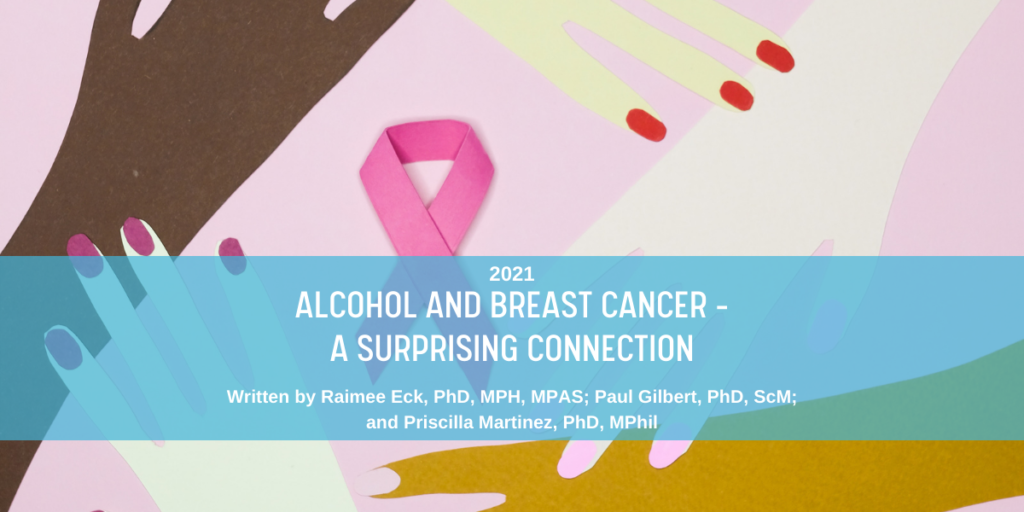Alcohol and Breast Cancer – A Surprising Connection

By Raimee Eck, PhD, MPH, MPAS; Paul Gilbert, PhD, ScM; and Priscilla Martinez, PhD, MPhil
Most people know about the harms that can come from drinking—from hangovers to addiction—but few people are aware of the link between alcohol and cancer. In fact, alcohol is considered a carcinogen,1 and it has been established as a cause of several cancers, including mouth and throat, liver, colon, and female breast cancers.2 The more a person drinks alcohol, the greater their risk of these cancers. For women, alcohol use is one of the top causes of breast cancer, and just over one in six breast cancer deaths is due to alcohol.
Since the start of the COVID-19 pandemic, the public health community has been more and more concerned about increasing alcohol use. Data are still emerging, but drinking in the US has increased, likely as a coping response to stress during the pandemic.3-5 However, the change in whether people drink—and how much they drink—has not been the same for everyone. Women who drink have increased how often and how much they drink more than men. Even before the pandemic, some groups of women (for example, middle aged and older women) have increased their drinking closer to men’s levels.6, 7 In addition, alcohol use is an ongoing concern in Iowa.8 The state has consistently ranked above the national average for adult binge drinking episodes, which are defined as four or more drinks on a single occasion for women and five or more drinks on a single occasion for men.
While we’ve known for decades that alcohol can cause breast cancer, the majority of American women are unaware of this important link. Using data from the National Survey of Family Growth, one study found that only 25% of women between the ages of 18-49 said that alcohol was a risk factor for breast cancer.9 A more recent study asked people of drinking age at the Minnesota State Fair if they knew about the link between alcohol and different types of cancers. They found that knowledge of the link was lowest for breast cancer.10 Given that alcohol use among women is on the rise and appears to be accelerated by the COVID-19 pandemic, it is critical that women are aware of the negative impact of alcohol use on their breast health.
The alcohol industry is taking advantage of this low awareness by using the pink awareness ribbon or supporting breast cancer charities, all while manufacturing or selling products that contain a cancer-causing ingredient—a tactic called Pink Washing. Not only is it a conflict of interest to encourage use of a cancer-causing product in order to support work to reduce or eliminate cancer, but most campaigns do not list a specific charity, specific dollar amounts to be donated, or the types of cancer-related activities to be funded. In other words, there is limited transparency into the actual impact of such fundraising campaigns versus the impact on increased sales profit to the company from just marketing in general.
Health education campaigns to raise awareness that alcohol is a risk factor for breast cancer have been conducted in Australia11 and the UK12, and this year has seen the launch of more campaigns about the overall link between alcohol use and cancer in Australia13 and Europe14. These campaigns have been successful at raising awareness among women about alcohol use and breast cancer, and for increasing support for alcohol policies to reduce to drinking.15 In the US, health campaigns about alcohol and breast cancer are much less common. However, the Drink Less for Your Breasts campaign was launched in California in March, 2021, and is the first of its kind. It is an ongoing social media campaign and has reached about 300,000 young women so far.
For cancer prevention, the best strategies are to get regular exercise, eat healthy foods, quit smoking, and avoid alcohol.16 The American Cancer Society even recommends no alcohol for cancer prevention; but if you choose to drink, stay within the levels recommended by the 2020-2025 Dietary Guidelines for Americans (no more than one drink per day for women, no more than two drinks per day for men). Other best practices to reduce the harms from alcohol include maintaining taxes on alcohol, limited hours and days of sales, and restricting outlet density (among others).17
Interested in learning more? You can follow the Drink Less for Your Breasts campaign on Instagram or Facebook, or visit their webpage (drinklessforyourbreasts.org). Additional information on the link between alcohol and cancer is available from the American Cancer Society and the National Cancer Institute.
Contact the Authors

Raimee Eck, PhD, MPH, MPAS
Advocacy Committee Co-chair, Maryland Public Health Association
Principal, Sonrisa Solutions

Paul Gilbert, PhD, ScM
Associate Professor
Department of Community and Behavioral Health
University of Iowa
[email protected]

Priscilla Martinez, PhD, MPhil
Scientist
Alcohol Research Group, Public Health Institute
[email protected]
Dr. Martinez is the Principal Investigator of the Drink Less for Your Breasts project, which was funded by the California Breast Cancer Research Program Grant #25QB-0500.
References
- National Toxicology Program (2016). Report on Carcinogens, 14th Edition. Research Triangle Park NC: US Department of Health and Human Services, Public Health Service.
- World Health Organization (2018). Global Status Report on Alcohol and Health 2018. Geneva, Switzerland: World Health Organization.
- Barbosa C, Cowell AJ, Dowd WN (2021). Alcohol consumption in response to the COVID-19 Pandemic in the United States. J Addict Med; 15(4): 341-344.
- Pollard MS, Tucker JS, Green HD Jr (2020). changes in adult alcohol use and consequences during the COVID-19 pandemic in the US. JAMA Netw Open; 3(9): e2022942.
- Brooks SK, Webster RK, Smith LE, Woodland L, Wessely S, Greenberg N, et al. (2020). The psychological impact of quarantine and how to reduce it: Rapid review of the evidence. Lancet; 395(10227): 912-20.
- White A, Castle I-J P, Chen CM, Shirley M, Roach D, Hingson R (2015). Converging patterns of alcohol use and related outcomes among females and males in the United States, 2002-2012. Alcohol Clin Exp Res; 39(9): 1712-26.
- Keyes KM, Jager J, Mal-Sarkar T, Patrick ME, Rutherford C, Hasin D (2019). Is there a recent epidemic of women’s drinking? A critical review of national studies. Alcohol Clin Exp Res; 43(7): 1344-1359.
- Iowa Department of Public Health (n.d.). Five-Year Substance Abuse Prevention Strategic Plan for the State of Iowa. Division of Behavioral Health, Bureau of Substance Abuse.
- Khushalani JS, Qin J, Ekwueme DU, White A (2019). Awareness of breast cancer risk related to a positive family history and alcohol consumption among women aged 15-44 years in United States. Prev Med Rep; 17: 101029-.
- Calvert CM, Toomey T, Jones-Webb R. Are people aware of the link between alcohol and different types of Cancer? BMC Public Health 2021; 21(1): 734.
- Mental Health Commission and Cancer Council Western Australia. Alcohol and Health ‘Spread’: Alcohol causes cancer. Reduce your drinking to reduce your risk. 2020. https://alcoholthinkagain.com.au/campaigns/alcohol-and-health-spread/
- Martin N, Buykx P, Shevills C, Sullivan C, Clark L, Newbury-Birch D (2018). Population level effects of a mass media alcohol and breast cancer campaign: A cross-sectional pre-intervention and post-intervention evaluation. Alcohol Alcohol; 53(1): 31-8.
- Foundation for Alcohol Research and Education F. Campaign highlighting alcohol and cancer link launched in Canberra: Alcohol and cancer: Reduce your risk. 2021. https://fare.org.au/campaign-highlighting-alcohol-and-cancer-link-launched-in-canberra/
- European Commission. Europe’s Beating Cancer Plan: A new EU approach to prevention, treatment and care. 2021. https://ec.europa.eu/commission/presscorner/detail/en/ip_21_342.
- Martin N, Buykx P, Shevills C, Sullivan C, Clark L, Newbury-Birch D (2018). Population level effects of a mass media alcohol and breast cancer campaign: A cross-sectional pre-intervention and post-intervention evaluation. Alcohol Alcohol; 53(1): 31-8.
- American Cancer Society. Can I Lower My Risk of Breast Cancer? https://www.cancer.org/cancer/breast-cancer/risk-and-prevention/can-i-lower-my-risk.html
- Community Preventive Services Task Force. What Works Fact Sheet: Preventing Excessive Alcohol Consumption. Centers for Disease Control and Prevention. https://www.thecommunityguide.org/resources/what-works-preventing-excessive-alcohol-consumption.
